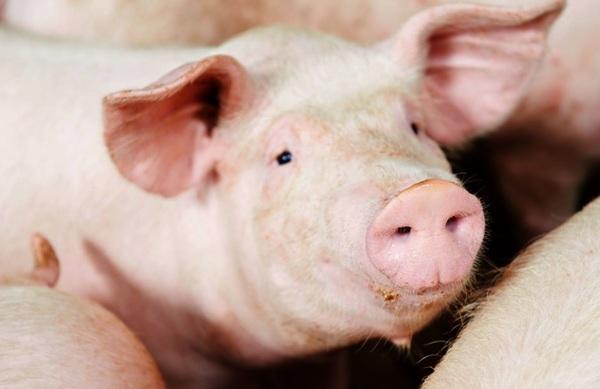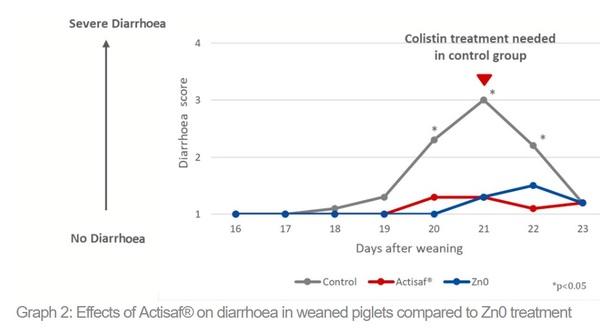Modern swine production allowed to increase the productivity at farm level.
Due to higher prolificacy, farmers are managing bigger litters with lower individual weight at weaning. Hence, piglets are confronted with a higher susceptibility to bacterial or viral diseases at birth and after weaning.
Biosecurity and farm management are the first basic leverages to control the health status of the animals and limit pathogen pressure: good housing management, stocking, density control in the pens, proper climatic conditions (including temperature and ventilation) and optimal quality of the water and feed must be implemented closely. Vaccination is helpful to prevent diseases. In the case of disease outbreaks, antibiotic treatment to cure the animals is a necessity.
Nowadays, the responsible use of antibiotics or other health promoter such Zinc Oxide (Zn0) are a huge topic concerning both animal and human health. The use of antibiotics in piglet diets is decreasing globally (like and in Europe, the prescription of antibiotics as a prophylaxis in the piglet’s feed is no longer allowed) for the last four years in a row. However, the industry must continue to reduce antibiotic usage while maintaining or improving current animal welfare standards and this is particularly pertinent during the post weaning phase. Nowadays, vets and nutritionist’s are working together to identify alternative solutions to improve animal health and performance.
Use of Zinc Oxide: what is the interest and what are the limits?
The trace element Zinc (Zn) is an essential nutritional component in the various metabolic functions of pigs: it influences gene expressions, proteins, and hormone structure. It helps to stabilize the membrane and the cytoskeleton of the cells and has a structural, catalytic or regulatory role within 300 enzymes involved in most basic metabolic functions (carbohydrates, lipids, proteins, nucleic acids).
- A decrease in the piglet’s feed intake (Zinc = complement of Gustine, a protein implicated in gustatory acuity),
- An increase in diarrhoea due to a decrease in villi size,
- A decrease in growth, due to Zn deficiency, not allowing the enzyme systems to be activated, this system is fundamental for cell proliferation,
- Parakeratosis: imbalance of Ca/Zn Ratio in the feed (excess of Ca and/or deficiency of Zn),
- Deregulation of immune functions: Zn is involved in the development and function of the immune cells (nonspecific). Its deficiency also affects the development of acquired immunity by inhibiting some functions of Lymphocytes T (as cytokines production).

To have the right level of Zn in the diet, ZnO is the most widely used mineral source of supplementation, two times richer in Zinc than sulfate salts (ZnSO4).
However, due to Zn toxicity to plants and animals, since 2003 the European Union has defined the maximum ZnO concentration in complete feed and for all stages: 150mg/kg equivalent 150ppm (value expressed per kg of feed at 88% Dry Matter).
Zinc and the gastro-intestinal tract
Zn is associated with the maintenance and function of the gastrointestinal tract, especially the function of the villus and crypt in the intestines. As Zn helps to maintain the stability of the intestinal microflora, it supports a large diversity of coliforms in weaned piglets and reduces the susceptibility of pigs to E. coli infection. In our modern farm, ZnO is also used at pharmaceutical level to suppress scouring in the post-weaning phase. It has been confirmed that ZnO acts as an antimicrobial agent improving the function of the gastrointestinal tract by increasing mucosal thickness, villi height, and width of the small intestine.
In practice, ZnO to prevent diseases (such E. coli diarrhoea) is only on veterinary prescription with a current dosage of 2500-3100 ppm for 14 consecutive days. However, it is not uncommon to find starter diets supplemented with ZnO with a lower dose (1500-2100 ppm). The mode of action is as follows:
- Stabilize intestinal microbiota by acting on certain species of lactic acid bacteria and anaerobic bacteria and increase the diversity of intestinal bacteria by promoting the stability and the increase of the diversity of enterobacteria (the stability of the intestinal microflora, maintained by the diversity of coliforms, rather than the decrease in E. coli numbers, explains the effect of ZnO on the reduction of diarrhea (Katouli et al 1999)
- Strengthen the intestinal barrier strengthened at the level of tight junctions, while the possibility of adhesion to intestinal cells by E. Coli is reduced,
As a consequence, the risk of diarrhoea decreases, the consistency of the feces is improved, and ionic secretions are reduced.
- In addition, it appears from various literature sources that ZnO supplementation has a beneficial effect on the local and systemic immune functions in the piglet during the immediate post-weaning period, However, the mode of action of Zno is not currently accurately described in the literature. (Li et al., 2006, Martinez Montemayor et al., 2008, Ou et al., 2006, Sargeant et al., 2010)
Environmental issues and bacterial resistance:
Zn has a strong affinity for soils and because of its non-degradable character, it accumulates in manure. Assessments indicate a toxic risk for the different compartments (soils, aquatic). A recent calculation of the predictable zinc concentrations within soil shows that a continuous supply of ZnO via medicated premix leads to a gradual enrichment of the Zn in soils, which is further added to by Zn fed in feed (raw materials and additive) fed to the animals.
Today, the scientific community has highlighted to the animal production industry that there maybe a possible bacterial co-selection with ZnO. The mechanism of Zn resistance is based on the expression of bacteria efflux pumps. These are either Zn specific or may support other molecules, such as antibiotics, leading to a slight reduction in bacterial sensitivity to these inhibitors. On the other hand, Zn resistance genes are sometimes located on the same mobile genetic elements as antibiotic resistance genes, thus inducing a co-selection of antibiotic resistance. This is particularly the case with Staphylococcus aureus: the administration of ZnO leads to an increase in the number of methicillin-resistant S. aureus (MRSA) in the nasal cavities of treated pigs (Agerso et al., 2012).
Supporting the farmers with alternative tools for a progressive replacement of ZnO in post-weaning piglet diets
Today, various strategies are developed to help piglets overcome the challenge of weaning. One of those is to provide good nutrition to the piglets and their mothers. Nutritionists have developed different dietary formulations to ensure the health of animals and with the best zootechnical performance possible.
The choice of raw materials is crucial and specific additives can be added to improve the digestibility of the final feed. Several options can be used. Among them are the use of probiotics and specific ingredients.
Phileo Lesaffre Animal Care recommends using the
premium yeast probiotic Actisaf® in sows and piglets feed to improve their health status and zootechnical performance. Actisaf® supports the immune system development of piglets (Jang, Jurgens), balances microbiota (Kiros, 2018), reduces inflammation by its pathogen binding capacity (Zanello, 2010), prevents
E.coli disease (Zanello, Bernardy, Trevisi), and controls pathogen dissemination (Trockova).
Thanks to its key benefits Actisaf® allows an improvement in the performance of young piglets.







.jpg&w=3840&q=75)